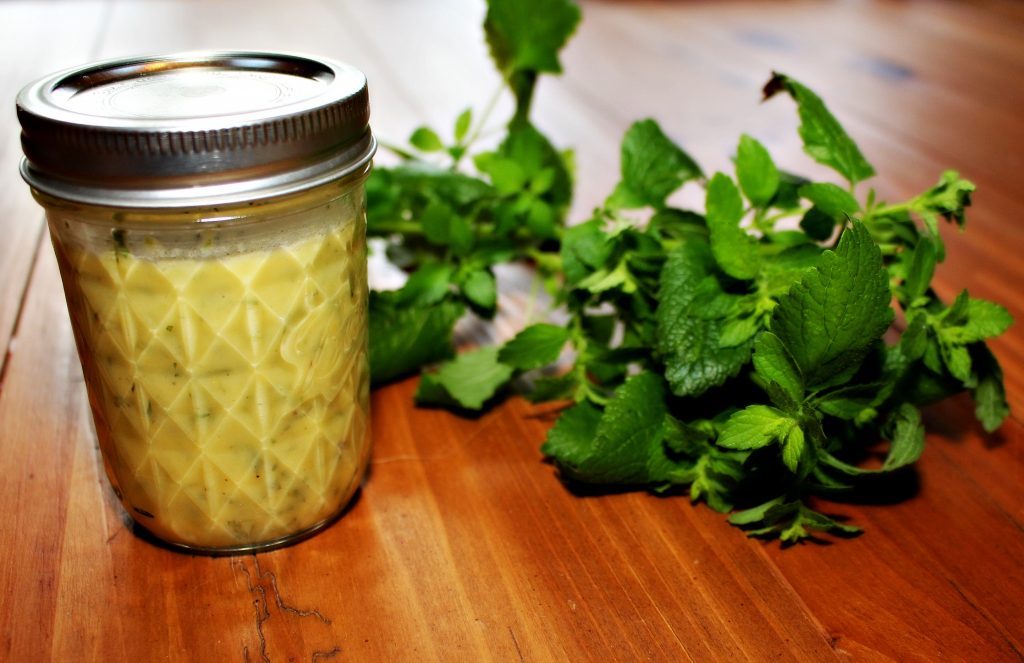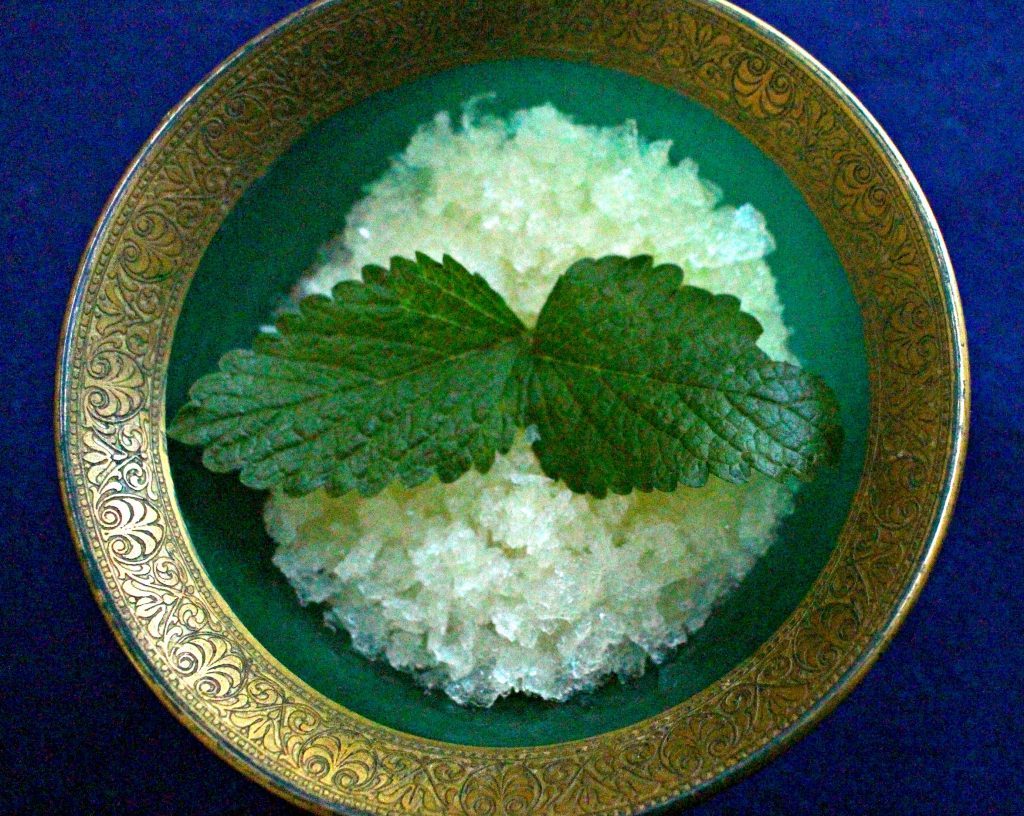First, a note on hakurei turnips–I understand that not everyone is receiving hakurei turnips these this week, so I won’t say too much about them for now. However, for those new to these great turnips here is a bit of information. These are called “salad turnips” because they are tender and great for salads and crudités. However, they can also be cooked (sauteeing and roasting are great options). They taste like a mild version of a radish. The leaves are also edible and can be eaten raw or cooked. Cut the leaves off of the bulbs once you get home and store them separately. The leaves will only last a couple of days, while the turnips will last a couple of weeks.
 Featured Item–Lemon Balm
Featured Item–Lemon Balm
The lemon balm is beautiful and quite plentiful right now at the farm, and regular harvesting will allow it to continue to grow and flourish, so this week I thought I would focus on this herb in the hopes of getting you to try it. You can find it at the very beginning of the perennial herb garden just outside the PYO gate.
Lemon balm, an herb that is part of the mint family native to the Mediterranean, has been used medicinally at least since ancient Greeks recognized its many healing virtues. Lemon balm has been claimed to remedy many ills. The most common uses for lemon balm today are to treat insomnia, anxiety and restlessness, colic, cold sores/herpes, and digestive distress. It is used in many forms. The leaves are often dried for tea and tinctures, and essential oils derived from the leaves are used to make salves, balms, and other beneficial healing products.
Lemon balm, as might be expected, looks an awful lot like mint, only its mature leaves are larger. It has a pleasant lemony smell when bruised, and the taste is mild lemon with a hint of mint. It’s mild lemony taste lends itself to many culinary uses. Here are a few:
- Infused Water—Place a large bunch of lemon balm in a pitcher with cold water and steep in the refrigerator for at least 8 hours. For an even more intense lemony flavor, add a slice or two of lemon.
- Hot Tea—To make hot tea with fresh lemon balm leaves, cover a large handful of lemon balm with barely boiling water (bubbles should rise but water should not be at a rolling boil. This allows the health and medicinal properties of the herb to remain intact). Steep for 10-15 minutes or until the tea is at a good sipping temperature.
- Sun Tea—Place a large handful of lemon balm in a quart jar. Cover with water and screw on lid. Place outside in a sunny area for about 4 hours. Remove leaves and refrigerate the sun tea. (this is like a slightly more intense form of infused water).
- To flavor dishes—add to soups or stews off heat right before serving. Mince and sprinkle on cooked fish or chicken. Or mince and add to grain salads or pasta dishes. Wonderful tossed with fresh fruit.
- Compound butter—soften a stick (or ½ cup) of grass fed, organic butter. Finely mince 1-2 tablespoons lemon balm (to taste) and add to butter along with 2 teaspoons lemon zest. Refrigerate. Use to top cooked fish or mix in with cooked rice, quinoa, or other grain.
- Pesto—Use in place of basil to make a pesto. If you are concerned that pure lemon balm might be too herby tasting on its own, mix in some parsley. Then add to pastas or use to top grilled chicken or fish.
- Lemon balm granita or sorbet—see recipe below
- Lemon balm vinaigrette or marinade—use lemon balm in your favorite vinaigrette or marinade recipe, or see recipe below.
- Infused oil—Fill a jar with clean and dried, fresh lemon balm. Fill jar almost full with a good quality extra virgin olive oil. Stir gently to release any air bubbles. Screw lid on jar and allow to sit in a dark, cool place for 2-6 weeks. Start tasting after 2 weeks and stop steeping once the oil is infused to your liking. Remove lemon balm and store in refrigerator. Best used with low heat cooking or as a finishing oil.
- Infused vinegar—Fill jar with clean, dried fresh lemon balm. Cover with apple cider vinegar or light vinegar of your choice. Close with a non metallic lid or place plastic wrap under a metallic lid. Let sit in a cool, dark place for 2 weeks. Remove lemon balm and store infused vinegar in the refrigerator. Use for vinaigrettes and marinades.
- Lemon balm syrup for drinks—in a small saucepan heat 1 cup water and 2 cups sugar with a large bunch of clean fresh lemon balm. Bring just to a simmer, stirring to completely dissolve sugar. Remove from heat and allow to steep for 2 hours. Remove lemon balm and place syrup in a glass jar. Refrigerate and use when desired to sweeten both alcoholic and non alcoholic drinks.
- Dry the leaves for tea—tie small bunches of lemon balm together at the bottom of the stems (large bunches more easily develop mold). Hang upside down in a well ventilated area away from sunlight and humidity. It should take about 1 week for the leaves to dry, depending upon the amount of humidity. If you wish to keep away dust, you can wrap the bunches loosely in cheesecloth or muslin (but not plastic).
Here is an easy vinaigrette and marinade recipe that works especially well with chicken or fish.

- - Zest of one lemon
- - ¼ cup freshly squeezed lemon juice
- - 2 tablespoons white wine vinegar or cider vinegar
- - 1 tablespoon Dijon mustard
- - ¼ teaspoon salt
- - pinch fresshly ground black pepper
- - 2 tablespoons finely minced fresh lemon balm leaves
- - 1 teaspoon honey, optional for vinaigrette. Not necessary for marinade
- Place all ingredients except the lemon balm in a blender bowl or, if using a stick blender, a container tall enough to contain a large part of the handle (to avoid splashes). Blend until smooth and emulsified. Stir in lemon balm. Allow to sit at least 30 minutes or make ahead and refrigerate for several hours to develop the flavors.
This recipe makes enough to marinate 3 chicken breasts or to marinate 2 small chicken breasts with enough remaining vinaigrette for 2 salads. Consider doubling the recipe if you want to marinate more chicken or use as both vinaigrette and marinade (as in a chicken salad).
I would also like to share a super refreshing dessert recipe, lemon balm granita. If you don’t wish to make granita, you can run the chilled lemon balm mixture through your ice cream maker to make sorbet.

Lemon Balm Granita
INGREDIENTS:
– 3 1/2 cups water
– 1/2 cup raw, unfiltered honey
– 1/4 cup freshly squeezed lemon juice
– zest of one organic lemon
– 3/4 packed cup clean fresh lemon balm (strip tender stems and leaves only. Discard tough main stem)
METHOD:
1. In a medium saucepan, heat water and honey, stirring constantly, just until honey dissolves. Do not allow mixture to get hot or boil. Remove from heat and allow to cool.
2. Place honey mixture into a blender and add lemon juice, lemon zest, and lemon balm. Blend until smooth and light green. Pour mixture over a sieve into a bowl. Drain well, but avoid pushing foam through sieve. Discard foam and bits of lemon balm.
3. Pour mixture into a 7 X 11” glass pyrex or a 9 X 11” cake pan. Place uncovered in the freezer. Freeze for 2-3 hours, depending upon how warm your mixture is and the size of your pan (the larger the pan, the greater the surface area and the quicker the mixture will freeze). Take a fork and scrap mixture to break up ice into small granules. Chop up any big chucks. The point is to create tiny granules of ice to form granita. Don’t worry that much of the mixture is still liquid. Return to the freezer and scrape up mixture again, every hour or so, until it is completely frozen and texture resembles granita. Cover and keep frozen until ready to serve.
